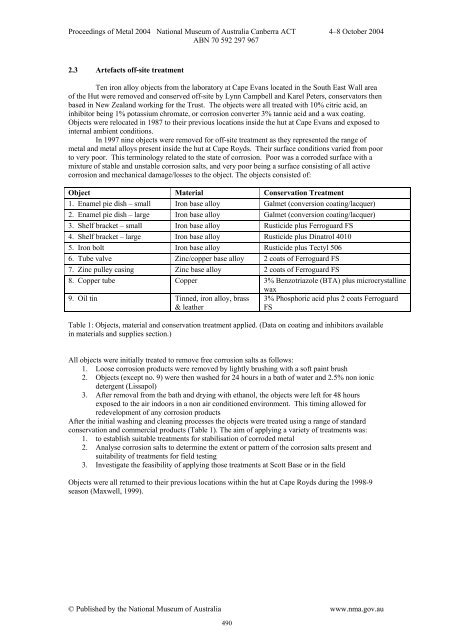Section 4: Composite artefacts (PDF 20858kb) - National Museum of ...
Section 4: Composite artefacts (PDF 20858kb) - National Museum of ...
Section 4: Composite artefacts (PDF 20858kb) - National Museum of ...
- No tags were found...
Create successful ePaper yourself
Turn your PDF publications into a flip-book with our unique Google optimized e-Paper software.
Proceedings <strong>of</strong> Metal 2004 <strong>National</strong> <strong>Museum</strong> <strong>of</strong> Australia Canberra ACT 4–8 October 2004ABN 70 592 297 9672.3 Artefacts <strong>of</strong>f-site treatmentTen iron alloy objects from the laboratory at Cape Evans located in the South East Wall area<strong>of</strong> the Hut were removed and conserved <strong>of</strong>f-site by Lynn Campbell and Karel Peters, conservators thenbased in New Zealand working for the Trust. The objects were all treated with 10% citric acid, aninhibitor being 1% potassium chromate, or corrosion converter 3% tannic acid and a wax coating.Objects were relocated in 1987 to their previous locations inside the hut at Cape Evans and exposed tointernal ambient conditions.In 1997 nine objects were removed for <strong>of</strong>f-site treatment as they represented the range <strong>of</strong>metal and metal alloys present inside the hut at Cape Royds. Their surface conditions varied from poorto very poor. This terminology related to the state <strong>of</strong> corrosion. Poor was a corroded surface with amixture <strong>of</strong> stable and unstable corrosion salts, and very poor being a surface consisting <strong>of</strong> all activecorrosion and mechanical damage/losses to the object. The objects consisted <strong>of</strong>:Object Material Conservation Treatment1. Enamel pie dish – small Iron base alloy Galmet (conversion coating/lacquer)2. Enamel pie dish – large Iron base alloy Galmet (conversion coating/lacquer)3. Shelf bracket – small Iron base alloy Rusticide plus Ferroguard FS4. Shelf bracket – large Iron base alloy Rusticide plus Dinatrol 40105. Iron bolt Iron base alloy Rusticide plus Tectyl 5066. Tube valve Zinc/copper base alloy 2 coats <strong>of</strong> Ferroguard FS7. Zinc pulley casing Zinc base alloy 2 coats <strong>of</strong> Ferroguard FS8. Copper tube Copper 3% Benzotriazole (BTA) plus microcrystallinewax9. Oil tin Tinned, iron alloy, brass& leather3% Phosphoric acid plus 2 coats FerroguardFSTable 1: Objects, material and conservation treatment applied. (Data on coating and inhibitors availablein materials and supplies section.)All objects were initially treated to remove free corrosion salts as follows:1. Loose corrosion products were removed by lightly brushing with a s<strong>of</strong>t paint brush2. Objects (except no. 9) were then washed for 24 hours in a bath <strong>of</strong> water and 2.5% non ionicdetergent (Lissapol)3. After removal from the bath and drying with ethanol, the objects were left for 48 hoursexposed to the air indoors in a non air conditioned environment. This timing allowed forredevelopment <strong>of</strong> any corrosion productsAfter the initial washing and cleaning processes the objects were treated using a range <strong>of</strong> standardconservation and commercial products (Table 1). The aim <strong>of</strong> applying a variety <strong>of</strong> treatments was:1. to establish suitable treatments for stabilisation <strong>of</strong> corroded metal2. Analyse corrosion salts to determine the extent or pattern <strong>of</strong> the corrosion salts present andsuitability <strong>of</strong> treatments for field testing3. Investigate the feasibility <strong>of</strong> applying those treatments at Scott Base or in the fieldObjects were all returned to their previous locations within the hut at Cape Royds during the 1998-9season (Maxwell, 1999).© Published by the <strong>National</strong> <strong>Museum</strong> <strong>of</strong> Australia www.nma.gov.au490
















